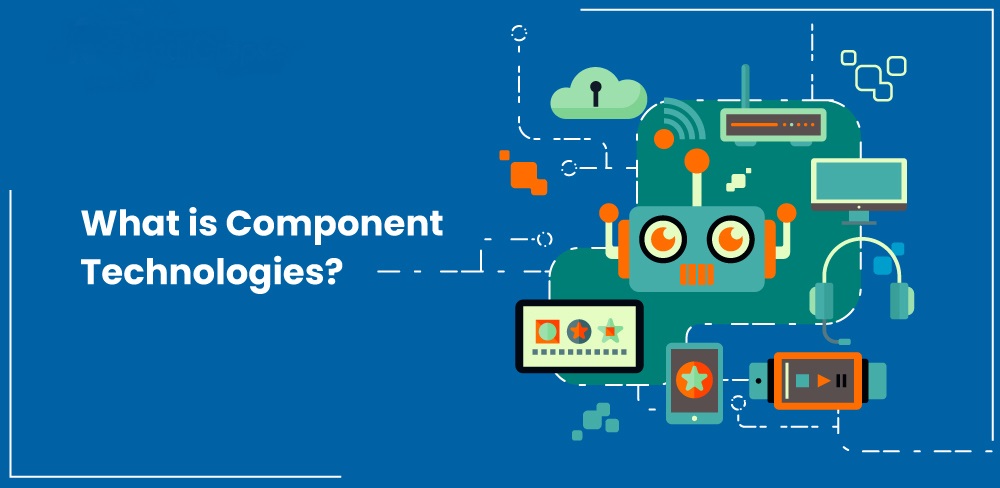Today technologies’ growth and performance have been revolutionized by component technology, which is now recognized as a critical factor. Component technology is now essential to many businesses because it can improve adaptability, versatility, and connectivity. The present piece examines component technology’s relevance in promoting creativity and productivity and its enormous effects across various industries, from computer programming to electronics. Thorough research reveals that component technology is no longer merely an ongoing phenomenon but an unpredictable force that will influence how innovation develops in the coming years.
What Is Component Technology?
Using flexible, recyclable parts, organizations are designed and developed using component technology. They may include physical components or applications that offer particular features. Designers and scientists can speed up their work, increase productivity, and raise the overall quality of their finished goods by utilizing pre-designed parts. Component technology has substantial uses in computer programming, gadgets, producing goods, and telecom and encourages reuse, compatibility, and direct connection. Enabling cooperative environments makes building complicated structures possible, lowering fees, and stimulating development.

What Are The Types Of Component Technology?
There are some significant types of component technology which are discussed below.There are various types of component technologies used in software development. One prominent type is object-oriented components, which are created using languages like Java and C++. These components encapsulate data and behavior, promoting reusability and modularity.
Web components are another type that leverages standardized web technologies such as HTML, CSS, and JavaScript. They enable the development of reusable UI elements for web applications, allowing for encapsulation and reuse of web functionality.
Enterprise JavaBeans (EJB) is a component-based architecture specifically designed for enterprise-level applications in Java. EJB provides server-side components that encapsulate business logic and can be deployed in distributed environments, offering features like transaction management and security.
In the Microsoft ecosystem, .NET components play a crucial role. They are built using the Microsoft .NET framework, supporting languages like C# and VB.NET. These components, known as assemblies, are self-contained units that can be easily reused and versioned.
Service-oriented architecture (SOA) is an architectural style that focuses on loosely coupled and interoperable services. Services are self-contained, modular components with well-defined interfaces, allowing them to be invoked over a network. SOA promotes flexibility and scalability by enabling the composition of applications from various services.
These are some of the main types of component technology utilized in software development, each offering distinct advantages and supporting different aspects of the development process.
Technologies For Producing Parts
The production component technology’s primary objective is to utilize flexible parts in the production industry. It has uniform or modular components that can be combined or incorporated into more complex systems or goods. Production procedures are more flexible, adaptable, and customizable thanks to modular designs and features that have been assembled.
There are various technologies available for producing parts, each with its own advantages and applications. One commonly used technology is traditional subtractive manufacturing, which involves removing material from a solid block using techniques such as milling, turning, or drilling. This method is suitable for producing parts with high precision and complex geometries from a wide range of materials.
Another popular technology is additive manufacturing, commonly known as 3D printing. It involves building parts layer by layer using materials such as plastic, metal, or ceramics. 3D printing offers design flexibility, allowing the creation of complex shapes and customized parts with reduced material waste. It has found applications in industries such as aerospace, automotive, and healthcare.
Injection molding is a widely used technology for mass production of plastic parts. It involves injecting molten plastic into a mold cavity and allowing it to solidify. Injection molding enables the production of high-quality, repeatable parts at a rapid rate, making it suitable for large-scale manufacturing.
Casting is a process that involves pouring a molten material, such as metal or resin, into a mold and allowing it to solidify. This technique is commonly used for producing metal parts with complex shapes and is particularly useful for manufacturing large components.
Sheet metal fabrication is employed to create parts from flat metal sheets. Techniques like cutting, bending, and welding are used to transform the sheets into the desired shape. Sheet metal fabrication is widely used in industries like construction, automotive, and electronics.
Computer numerical control (CNC) machining combines precision tools with computer control to produce parts with high accuracy. It is commonly used for both metal and plastic materials and can create complex parts with tight tolerances.
These are just a few examples of the technologies available for producing parts. The choice of technology depends on factors such as the desired material, complexity of the part, production volume, and cost considerations. Manufacturers often employ a combination of these technologies to meet their specific requirements.
Innovation For Connectivity Components
The technology used in telecommunication networks and structures includes the parts and protocols utilized in those networked systems. It contains components like transceivers, routers, firewalls, and others, as well as protocols and communications interfaces. These elements make it possible for communication equipment to be seamlessly integrated and interoperable.

The Technology Of Mechanical Components
Utilizing physical elements in mechanical engineering and systems is called automated component technology. It comprises gears, bearings, motors, actuators, valves, and structural parts. These components of technology are essential in several industries, including the producing goods, automation, the aviation sector, and automotive sectors.
The technology of mechanical components encompasses a wide range of techniques and processes used in the design, manufacturing, and assembly of various mechanical parts and systems. One fundamental aspect of this technology is the selection and utilization of appropriate materials for the components. This involves considering factors such as strength, durability, corrosion resistance, and thermal properties to ensure optimal performance.
The design process for mechanical components involves utilizing computer-aided design (CAD) software to create detailed models and simulations. CAD allows engineers to visualize and analyze the behavior of the components under different conditions, optimizing their performance and functionality. Finite element analysis (FEA) is often employed to simulate and predict the structural integrity and stress distribution within the components.
Furthermore, advancements in additive manufacturing, or 3D printing, have revolutionized the production of mechanical components. This technology allows the creation of complex geometries and customized designs with reduced material waste. Additive manufacturing finds applications in rapid prototyping, small-batch production, and creating intricate structures that are difficult to produce using traditional methods.
Overall, the technology of mechanical components is a multidisciplinary field that combines engineering design principles, material science, precision manufacturing techniques, and assembly methods to create functional and reliable mechanical parts and systems for a wide range of industries, including automotive, aerospace, robotics, and industrial machinery.
The Technology Of Electronic Components
Combining and using electrical parts are the main objectives of this form of component technology, which is unique to electronic systems. Some features are resistors, capacitors that store energy diodes, transistors, integrated circuits, wiring connections, and screens. Electrical component technology is essential in designing and producing electrical systems and devices.
Technical Hardware Components
The use of physical parts or functional units in creating hardware systems is known as hardware component technology. These parts could be integrated circuits, sensors, CPUs, memory modules, or interfaces for communications. Hardware component technologies include linked element solutions and system-on-chip structures.
Technical hardware components refer to the physical elements that make up computer systems and other electronic devices. These components work together to enable the functionality and operation of various technological systems.
One crucial hardware component is the central processing unit (CPU) or microprocessor. The CPU serves as the “brain” of the computer, executing instructions and performing calculations. It handles tasks such as data processing, control, and coordination of other hardware components.
Memory modules, including random-access memory (RAM) and read-only memory (ROM), are essential components that store data and instructions temporarily or permanently. RAM provides fast access to data and instructions that the CPU needs for immediate processing, while ROM contains permanent instructions and data that are not typically modified.
Storage devices, such as hard disk drives (HDDs) and solid-state drives (SSDs), store and retrieve data over the long term. HDDs use rotating magnetic disks to store data, while SSDs utilize flash memory for faster and more reliable data storage.
Input devices enable users to interact with the computer or device, including keyboards, mice, touchscreens, and scanners. These devices allow users to input commands, data, and instructions into the system.
Power supply units (PSUs) convert electrical power from an outlet into usable power for the computer or device. They provide the necessary voltage and current required for all hardware components to function properly.
These are just a few examples of technical hardware components found in computer systems and electronic devices. Each component plays a vital role in enabling the functionality and performance of modern technological systems.

Software Component Technology
The creation and use of software parts are the main objectives of this form of component technology. For reuse in software design, it consists of frameworks, libraries, modules, or packages that encapsulate particular functionalities or characteristics. .NET components, JavaBeans, and component-based frameworks for building, like Angularjs or Reactive, are some examples.
Features Of Component Technology
Reuse
Various projects, apps, or systems can use components technology because they are made to be reused. They eliminate the need to continuously design identical operations by encapsulating particular actions or capabilities and making them easily integrable into multiple settings. Reusability conserves time, money, and labour by using pre-existing components rather than starting from the ground up.
Version Administration And Upkeep
Version management methods are frequently present in technological elements, permitting upgrades, problem corrections, and advancements. Version control makes it possible to maintain systems correctly and guarantees they can be updated with fresher versions of elements without impairing their current functionality. This quality makes permanent system upkeep and development more accessible.
The Modular Nature
Because they’re autonomous and modular, parts may work independently or can be combined with other components to form more extensive networks. Modular systems can be designed with more freedom and allow designers to concentrate on creating particular parts while affecting the fundamental structure of the entire framework.
The Ability To Configure
Elements frequently provide configuration settings or characteristics that can be changed to customize their behaviour to meet particular needs. Configurable components technology can be easily adapted to various applications while necessitating substantial alterations or coding adjustments. This quality improves the ability to adjust and the diversity of elements.
The Ability To Be Tested
Testing modules independently allows for a practical and complete evaluation of specific capabilities. This characteristic will enable engineers to concentrate on particular elements without setting up complicated systems, making debugging easier. Before incorporation into more extensive procedures, credibility assures the dependability and quality of pieces.
The Encapsulation
The inner aspects of the implementation are hidden, and only the essential associations or APIs Application Programming Interfaces are exposed through components technology, which enclose specific capabilities. The internal data and logic of the element are shielded by this encasing, improving upkeep, reuse, and worry differentiation.
Interchangeability
Interconnection is promoted by the effortless integration of components with one another or within systems. They feature a well-defined interface that allows pieces created by various groups or companies to be seamlessly integrated and communicated. The capacity to join and combine elements into a functioning system is ensured by interconnection.
Significance Of Component Technology
Additionally, component technology has significantly impacted the discipline of circuits, especially within integrated circuits and electronic systems. Component technology has evolved into an essential element of modern electronic devices with the introduction of System-on-Chip (SoC) concepts. SoC concepts combine many functional, including manufacturers, memories, and connectivity connections, onto only one chip. Electronic appliances benefit from the combination by being smaller and less complicated while performing better and using less power. Component technology enables scientists to create extraordinarily interconnected and adaptable infrastructure, facilitating the development of cutting-edge mobile devices, wearables, and the Internet of Things, or IoT, gadgets that are becoming commonplace in everyday life.
Future Of Component Technology
There are some critical future discoveries by component technologies
Enhanced Connectivity And Modularity Is
The modularity and interoperability of component technology are anticipated to increase, enabling effortless integration of elements across various systems and platforms. Using existing features and encouraging cooperation between programmers and businesses will make it easier to construct complicated systems.
Cyber Security Based On Components
In the future of component technology, cybersecurity will be a crucial factor. Developing secure and reliable components and defined safety procedures and standards for component integration will all be pursued. In addition to ensuring the system’s reliability and anonymity, this will assist in reducing the risks brought on by component problems.
Test And Verification Of Advanced Components
Greater demand for reliable testing and verification techniques will increase as component-based systems become increasingly sophisticated. Future advancements will concentrate on improving component technology testing approaches, including computerized testing, training, and verifying methodologies to guarantee the dependability and quality of integrated systems.
Network Of Things
Component technology will be crucial to the growth and interoperability of IoT ecosystems, given the exponential growth of IoT devices. IoT systems’ scalability and flexibility will be enhanced using modular sensors, actuators, and communication modules, making integration and customization easier.
Future Generations Should Take This As A Career
A career in component technology may appeal to the younger demographic because of the field’s rising demand, chances for innovation and resolving issues, cooperation through freely available populations, and opportunity for continuous development and learning. It provides the possibility to work on innovative projects, long-term employment opportunities, and the chance to progress technology. When considering a career in component technological fields, people should evaluate their enthusiasm, ability to solve problems, and commitment to keeping current in this exciting profession.

Disadvantages Of Technology
Using external components or frameworks is common in component-based programming. This reliance could be safe if the element is maintained correctly, has adequate documentation, or is outdated. Problems like incompatibility disputes, security flaws, or restricted maintenance may impact the general operation and performance of the system.
The component-based architecture implementation might be complicated, especially for those unfamiliar with the methodology. A solid grasp of the fundamental principles and frameworks is necessary to manage connections, ensure appropriate integration, and comprehend how parts interact. This learning curve can take some time and require extra assistance or training.
Component technology encourages modularity and reuse, but it can also, in some circumstances, limit the degree of customization. The generic nature of components and their adaptability to different contexts may cause trade-offs in the specialized functionalities they offer. Adapting or extending elements to fit particular needs could take more time or knowledge.
Open-Source Groups and Cooperative Environments in Components Development
Along with transforming specific industries, component technology has also spawned collaborative ecosystems. Component markets and databases have been made possible thanks to the component-based design, where programmers and companies can trade and share components. Because of these ecosystems, production time and costs can be cut by reusing and customizing already-existing features. Additionally, by letting developers concentrate on their core talents while utilizing the experience of others through component integration, they foster creativity. Therefore, component technology has sparked the development of open-source networks and collaborative projects, accelerating technological advancement.
Conclusion
In conclusion, component technology offers a bright professional path for the younger generation. Its rising demand and innovative potential provide long-term career possibilities. The area appeals to individuals looking for exciting professions due to its adaptability, collaboration chances, and continual learning. As component technology advances, it is anticipated that improved connectivity, cybersecurity precautions, cutting-edge testing methodologies, and the growth of IoT will influence its future. Overall, a career in component technology can offer fascinating chances to contribute to advanced initiatives and be a part of the technical developments that will change the world.




















